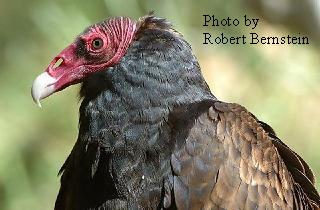Turkey Vultures (Cathartes aura) are large birds, with a 5 - 6 foot wingspan and weighing in at 4 - 5 pounds. They appear black at a distance yet are more dark brown than black in coloration. Their heads have no feathers, revealing a red flesh color. They have long, broad wings. These birds are larger than most common Midwest raptors, except for eagles. Their long wings look scalloped with points at their wingtips. The vulture's tail extends past its toe in flight. In flight, the Turkey Vultures hold their wings slightly raised, making a 'V' body formation, while eagles hold their wings straight.
As warmer climatic conditions and increased road-killed animals become common in the upper Midwest, these birds are extending their range northward.
The Turkey Vulture is one of the few birds of prey that can use its sense of olfaction (smell) to locate food. They are almost entirely carrion eaters and feed on medium-sized dead animals. These birds use their sight and acute sense of smell to find food during low level soaring flights. If feeding on decaying dead animals is not disgusting enough, these birds are known to defecate on their own legs to cool down.
This vulture nests primarily on the ground under bushes, or piles of fallen tree limbs. The female lays 2 eggs that are incubated for 38 - 41 days. Unlike most birds of prey, the chicks are fed regurgitated food. Turkey vultures have the unique capability of traveling long distances and then regurgitate partly digested carrion food. The young vultures fledge in 10 - 11 weeks.
Turkey vultures use diverse habitats. In Nebraska they are commonly seen in open habitats. They easily become familiar in suburban and urbanized locations. Since these birds prey upon dead animals and do not nest on structures they should be recognized as a welcome sight to the acreage.


